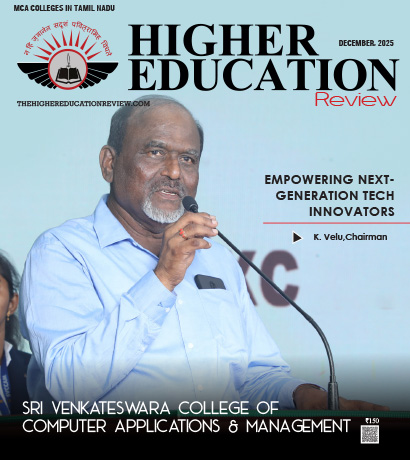Empowering Leadership: Building Skills For Team Engagement & Growth

Prof. Himanshu Rai, Director, IIM Indore
In a conversation with Keerthana, Correspondent, Higher Education Review Magazine, Prof. Himanshu Rai, Director, IIM Indore, shared his views and thoughts on what steps are to be taken to promote diversity, equity, and inclusion, as well as the most effective way to approach leadership development.
What strategies should be employed to adapt the leadership style based on the unique needs and strengths of the team?
The choice of an appropriate leadership style is basedon two crucial elements of team members: their capability and their willingness. For those who exhibit both technical proficiency and self-motivation, a monitoring leadership style is fitting. It entails granting them the autonomy to experiment, What strategies should be employed to adapt the leadership style based on the unique needs and strengths of the team?
The choice of an appropriate leadership style is basedon two crucial elements of team members: their capability and their willingness. For those who exhibit both technical proficiency and self-motivation, a monitoring leadership style is fitting. It entails granting them the autonomy to experiment, make mistakes, and autocorrect within a supportive environment.In the case of team members who possess technical proficiency but lack self-motivation, a supportive approach is valuable. Leaders can demonstrate support by actively engaging in tasks alongside them, dispelling any notions of work being beneath their dignity, and thus inspiring motivation.For individuals who are self-motivated but not yet competent, adopting a coaching role is effective. Leaders should provide guidance on how tasks should be accomplished and acknowledge and reward their efforts when executed effectively.Lastly, for those team members who neither demonstrate competence nor self-motivation, leaders should either let them go, or use a carrot-and-stick approach of using a combination of incentives and consequences to maximize team performance and development.
In your opinion, what steps are to be taken to promote diversity, equity, and inclusion within the team or organization?
Diversity within a team should be intentionally fostered by ensuring that it includes individuals from various backgrounds and demographics. To promote inclusion and equity, it is essential to create an environment where the specific conditions needed to motivate people from different genders and backgrounds are met. Everyone should have the opportunity to express their opinions openly, regardless of hierarchy, without concerns about their status. Leaders should provide motivation and coaching, encouraging diverse perspectives. It is important not to stigmatize or label those who offer different points of view as being against the organization. However, once a decision is made, team members should be encouraged to follow it without undue questioning. Promoting diversity may require structural changes within the organization, such as providing maternity and childcare support for both mothers and fathers and addressing the needs of individuals from diverse backgrounds.
Can you describe the most effective way to approach leadership development and how it would be helpful for individuals to grow and develop their leadership skills?
One should remember that stagnant water turns bad and is only a breeding ground for harmful insects. Any person who doesn't invest in himself or herself in learning new skills, particularly those pertaining to leadership, is likely to stagnate. Thus, one of the primary concerns for every human being should be to seek continuous improvement in terms of skills, knowledge, and attitude. To do so, the first step is to be aware of one's own current status of knowledge, skill, and attitude. Second, acknowledge that personal continuous improvement is needed, and the third step is to act upon it. From simple things like reading books, newspapers, or articles to pursuing lifelong learning through micro-credentials, people should try to enhance their skill set. Furthermore, leadership development is also about increasing one's emotional intelligence by practicing reflective listening. Listen not to respond but to understand others better.
In your opinion, what role does leadership play in fostering a culture of cross-functional collaboration within an organization?
Leadership is the process by which a person influences others to accomplish an objective and directs the organization in a manner that fosters collectiveness, cohesiveness, and coherence. In this context, it is imperative for a leader to consciously promote cross-cultural collaboration, as this is where innovation flourishes. The most innovative ideas often emerge at the intersections of various domains. Therefore, a leader should actively encourage the formation of teams comprising individuals from diverse functions and backgrounds and subsequently motivate them to engage in brainstorming, ideation, and the formulation of implementation strategies. Leaders should cultivate an environment conducive to experimentation, where teams are unafraid of potential failure, which should be appreciated and celebrated. Without such acknowledgment, valuable lessons cannot be learned and success cannot be achieved. For instance, the Chandrayaan 2 mission did not achieve all its predefined objectives. How-ever, it is essential not to denounce it as a failure but to view it as a valuable learning experience. By embracing the lessons drawn from this mission, Chandrayaan 3 successfully fulfilled all its objectives. Thus, the inability to meet an objective should not be seen as a failure but as a lesson to build upon for future success.
How do professionals stay updated on industry trends and best practices to improve their leadership skills?
Professionals should actively explore articles that discuss the skill sets essential in the post-4th industrial revolution, also known as Industry 5.0. Additionally, they should consider the executive education programmes offered by top global institutions, as these programmes are essentially built upon extensive research into the skill sets demanded by the future job landscape. Accumulating micro-credentials in various areas can contribute to a comprehensive understanding of their chosen domain and propel career advancement. Regardless of the approach, everyone should strive for continuous improvement in their respective fields, leveraging the available resources to enhance their skills and expertise.
Himanshu Rai, Director, IIM Indore
Prof. Himanshu Rai, his extensive background includes leading academic positions at esteemed institutions like SDA Bocconi, Milan, IIM Lucknow, and XLRI, coupled with a distinguished corporate journey at Tata Steel, where he molded Quality Systems and Communication Policy.
What strategies should be employed to adapt the leadership style based on the unique needs and strengths of the team?
The choice of an appropriate leadership style is basedon two crucial elements of team members: their capability and their willingness. For those who exhibit both technical proficiency and self-motivation, a monitoring leadership style is fitting. It entails granting them the autonomy to experiment, What strategies should be employed to adapt the leadership style based on the unique needs and strengths of the team?
The choice of an appropriate leadership style is basedon two crucial elements of team members: their capability and their willingness. For those who exhibit both technical proficiency and self-motivation, a monitoring leadership style is fitting. It entails granting them the autonomy to experiment, make mistakes, and autocorrect within a supportive environment.In the case of team members who possess technical proficiency but lack self-motivation, a supportive approach is valuable. Leaders can demonstrate support by actively engaging in tasks alongside them, dispelling any notions of work being beneath their dignity, and thus inspiring motivation.For individuals who are self-motivated but not yet competent, adopting a coaching role is effective. Leaders should provide guidance on how tasks should be accomplished and acknowledge and reward their efforts when executed effectively.Lastly, for those team members who neither demonstrate competence nor self-motivation, leaders should either let them go, or use a carrot-and-stick approach of using a combination of incentives and consequences to maximize team performance and development.
In your opinion, what steps are to be taken to promote diversity, equity, and inclusion within the team or organization?
Diversity within a team should be intentionally fostered by ensuring that it includes individuals from various backgrounds and demographics. To promote inclusion and equity, it is essential to create an environment where the specific conditions needed to motivate people from different genders and backgrounds are met. Everyone should have the opportunity to express their opinions openly, regardless of hierarchy, without concerns about their status. Leaders should provide motivation and coaching, encouraging diverse perspectives. It is important not to stigmatize or label those who offer different points of view as being against the organization. However, once a decision is made, team members should be encouraged to follow it without undue questioning. Promoting diversity may require structural changes within the organization, such as providing maternity and childcare support for both mothers and fathers and addressing the needs of individuals from diverse backgrounds.
Can you describe the most effective way to approach leadership development and how it would be helpful for individuals to grow and develop their leadership skills?
One should remember that stagnant water turns bad and is only a breeding ground for harmful insects. Any person who doesn't invest in himself or herself in learning new skills, particularly those pertaining to leadership, is likely to stagnate. Thus, one of the primary concerns for every human being should be to seek continuous improvement in terms of skills, knowledge, and attitude. To do so, the first step is to be aware of one's own current status of knowledge, skill, and attitude. Second, acknowledge that personal continuous improvement is needed, and the third step is to act upon it. From simple things like reading books, newspapers, or articles to pursuing lifelong learning through micro-credentials, people should try to enhance their skill set. Furthermore, leadership development is also about increasing one's emotional intelligence by practicing reflective listening. Listen not to respond but to understand others better.
In your opinion, what role does leadership play in fostering a culture of cross-functional collaboration within an organization?
Leadership is the process by which a person influences others to accomplish an objective and directs the organization in a manner that fosters collectiveness, cohesiveness, and coherence. In this context, it is imperative for a leader to consciously promote cross-cultural collaboration, as this is where innovation flourishes. The most innovative ideas often emerge at the intersections of various domains. Therefore, a leader should actively encourage the formation of teams comprising individuals from diverse functions and backgrounds and subsequently motivate them to engage in brainstorming, ideation, and the formulation of implementation strategies. Leaders should cultivate an environment conducive to experimentation, where teams are unafraid of potential failure, which should be appreciated and celebrated. Without such acknowledgment, valuable lessons cannot be learned and success cannot be achieved. For instance, the Chandrayaan 2 mission did not achieve all its predefined objectives. How-ever, it is essential not to denounce it as a failure but to view it as a valuable learning experience. By embracing the lessons drawn from this mission, Chandrayaan 3 successfully fulfilled all its objectives. Thus, the inability to meet an objective should not be seen as a failure but as a lesson to build upon for future success.
How do professionals stay updated on industry trends and best practices to improve their leadership skills?
Professionals should actively explore articles that discuss the skill sets essential in the post-4th industrial revolution, also known as Industry 5.0. Additionally, they should consider the executive education programmes offered by top global institutions, as these programmes are essentially built upon extensive research into the skill sets demanded by the future job landscape. Accumulating micro-credentials in various areas can contribute to a comprehensive understanding of their chosen domain and propel career advancement. Regardless of the approach, everyone should strive for continuous improvement in their respective fields, leveraging the available resources to enhance their skills and expertise.
Himanshu Rai, Director, IIM Indore
Prof. Himanshu Rai, his extensive background includes leading academic positions at esteemed institutions like SDA Bocconi, Milan, IIM Lucknow, and XLRI, coupled with a distinguished corporate journey at Tata Steel, where he molded Quality Systems and Communication Policy.

